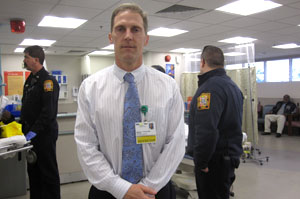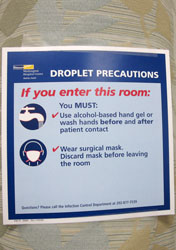What does it feel like to be working in an emergency department during this nasty flu season? Every day feels like Monday.
Monday is usually the busiest day of the week in the ER. “Now instead of having a Monday peak,” said Dr. Bill Frohna, who runs the emergency department at MedStar Washington Hospital Center in Washington, D.C., “it’s seven days a week of a Monday.”
Though it is still too soon to say whether this is a historically bad flu season or just a bad flu season, one thing is clear: Emergency rooms around the country are filled with a feverish throng that is much larger than last year. Washington Hospital Center had just 20 patients test positive for flu all of last year’s season. This season, as of Monday, there were already 179 cases positive for flu.
Maria McCoy is one of those patients. She had been miserable for more than a week with nausea, vomiting, and other symptoms. She’d had her flu shot, so she didn’t think it could be the flu. But she kept getting worse.
“I called 911. They brought me straight here,” said McCoy, 52, speaking on Thursday from a hospital bed in the ER, where she was, indeed, diagnosed with the flu. “It’s really miserable.”
McCoy has plenty of company in her misery.
“We started to see a lot of activity in the South and in the Southeast in in the middle of November and toward the end of November—which was about a month earlier than what we normally see,” said Tom Skinner, a spokesman with the US Centers for Disease Control and Prevention . “And since that time, activity really has picked up across the country to where most states are seeing either moderate to severe activity.”
According to the CDC, more than 112 million Americans have gotten a flu shot this season. The vaccine is about 60 percent effective, which is a decent percentage for a flu vaccine. But that means some people who get the shot, like McCoy, will still get the flu.
This year’s strain of the flu, H3N2, is particularly virulent, Frohna said. He compared the surge in patients to other years.
“Usually there’s a week or two ramp up, a peak, and then a week or two downturn,” Frohna said. “So far, we’ve been basically on a ramp up for about five weeks, and I’m not sure if we’ve seen the peak yet.”
According to Frohna, more patients are being admitted to the hospital because their symptoms are so serious.
“We’ve got patients wearing masks, we’ve got providers wearing masks to protect themselves and each other from the flu,” said Frohna.
To deal with it, he’s opened a half-dozen extra hospital beds, made sure patients with flu-like symptoms are isolated as quickly as possible and ordered extra supplies like IV poles. He’s also beefed up staffing of doctors and nurses.
Dr. Andrew Sama, president of the American College of Emergency Physicians, says this is exactly the sort of situation that ERs train for.
“There are emergency preparedness plans that occur in every hospital,” said Sama, whose organization is a trade group for emergency department doctors. “Even with all the excellent planning, you become constrained because of space and technology and personnel.”
In Allentown, Pennsylvania, one hospital had to put up a tent outside the ER to manage all the patients. New York state and the city of Boston have declared public health emergencies.
In Washington D.C., Frohna is eyeing the calendar and hoping that things start getting better soon.
“With inauguration coming, I’d just be tickled pink if the flu was on the downturn when a million visitors come to town,” he said. “It’s causing me to lose sleep already.”
This item was updated correct the number of flu cases seen at Washington Hospital Center this flu season. The correct figure is 179 cases as of Monday.








